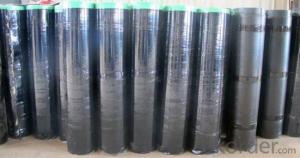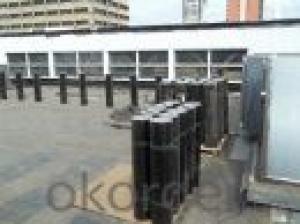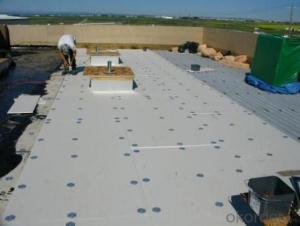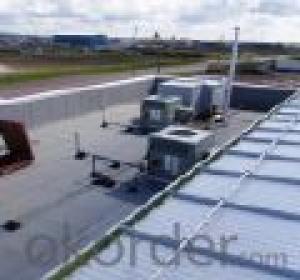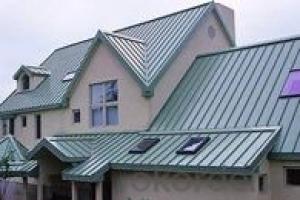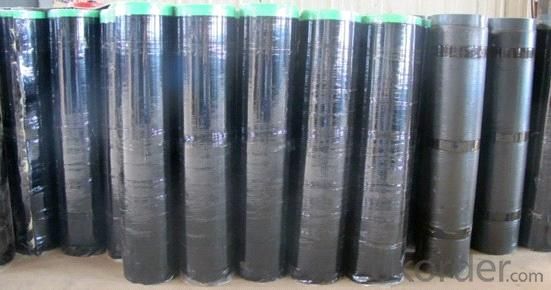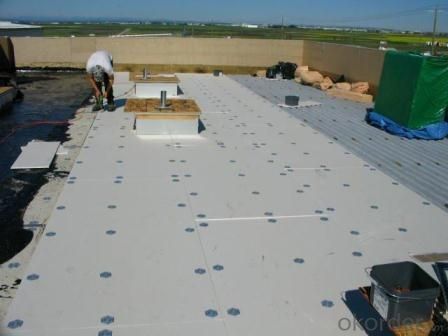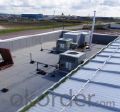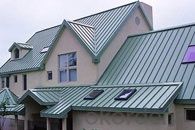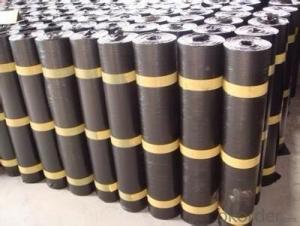CE Approved Waterproof Membrane Price , Self Adhesive Textured Roll SBS Waterproof Membrane
- Loading Port:
- Shanghai
- Payment Terms:
- TT OR LC
- Min Order Qty:
- 1000 m²
- Supply Capability:
- 200000 m²/month
OKorder Service Pledge
OKorder Financial Service
You Might Also Like
Product description
SBS Waterproof Membrane materials using polyester reinforcement for waterproofing is a new type of wateproof material,it's made from polyester felt as its reinforcement featuring high strength,elongation amd corrision resistance, SBS compound as its modifier for meeting the torched-on applications, it shall be covered with polyethylene membrane(PE),aluminium foil, colorful sand or mineral granule on its top surface and polyethylene membrane(PE)coated on its under face. This series of membrane is designed for the waterproofing of underground construction such as tunnel, subway, basement,roofs and pools etc.
Advantagee
1.1m or 2m width, we can produce as your requirment
2.Simple and Efficient Construct, Greatly Saving Construct Period
3.Advanced Production Line
4.Excellent Comprehensive Physical Properties
5.Stable Dimension
6.Wide Adaptability of Facing Material
7. Cold-applied construction with no open flame and self-adhesion without bonding agent make it safe, low- carbon, environmental, and economical.
8. Excellent adhesive performance guarantees the integrity of waterproof layer.
9. Good rubber elasticity, elongation and shear stress.
10. Good low-temperature property.
Application method
1) Widely used in the industrial and civil building roofing, underground, pool, tunnel, wooden and metal roofing.
2) Specially applied in the oil depot chemical factory, garment factory, and granary.
3) Especially used in cold places.
4) Tape used for sealing all construction material surfaces.
Our Services
1.If you need some advises for the waterproof construction, we have the best engineer to serve you.
2.We send the free samples to you by freight collect.
3.We will guarantee the quality and the competitive price.
4.We will give you the best packaging and safe shipping.
5.If any problem, we will always be right here waiting for you.
Storage:
Different types or specifications of products should be separated, not mixed.
Keep it dry and ventilated, protected from the sun or rain.
Storage temperature should never be higher than 45 °C. Pile up the membranes flatwise whose stockpile height never exceeds five layers. One layer is guaranteed if it is placed vertically.
Prevent it from inclination or In the process of transportation, it should be lying in case of inclination or lateral pressure. If necessary, cover it with felt-cloth.
Storage time is at least one year from manufacture date on if the product is under normal operation of storage.
Technical Parameters
Item | Index | ||||||
1 | Thickness of resin layer of the middle fabric ,mm≥ | - | - | 0.40 | 0.40 | 0.40 | |
2 | Tensile performance | Max tensile strength,N/cm ≥ | - | 120 | 250 | - | 120 |
Tensile strength,NPa ≥ | 10 | - | -10 | - | - | ||
Max elongation% ≥ | - | - | 15 | - | - | ||
Breaking elongation % ≥ | 200 | 150 | - | 200 | 100 | ||
3 | Heat treatment size change rate%≤ | 2.0 | 1.0 | 0.5 | 0.1 | 0.1 | |
4 | Cold bonding | -25°c No cracks | |||||
5 | Watertightness | 0.3mPa,2h waterproof | |||||
product show
SBS Membrane installation procedure:
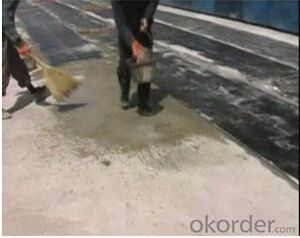
1.Base processing:the base surface must be clean,solid,level,dry;no grit,rift and loosing dust. For a large recess,fill it with cement mortar and then level it. Remove the protrusion and clean dust.If working on base slab or lateral face,water lowering should be done.
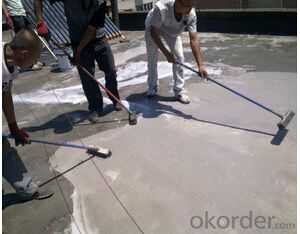
2. Painting primer:before laying the membrane,clean the dust on the surface of concrete base with dust catcher or dust-blower;then paint entirely with treatment agent of DY primer for waterproofing(for purpose of dust consolidation and high adhesive effect).
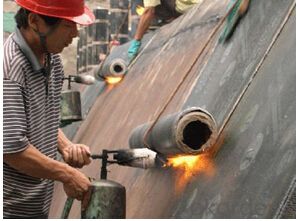
3.Heat to melt: place membrane correctly, fire torch, heat the membrane with base entirely, when the surface of the membrane is black and bright with a fusion layer, apply the membrane and press it into a solid and flat state.Before the membrane is cool, seal the edge of joint by float.
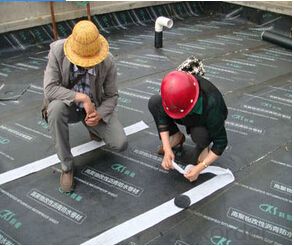
4.Requirements for lapping: There should be less than 3 layers of lapping, with the joint seams appearing as"T" type,avoid 4 layers of lapping.The width of longitudinal lapping is between 50 and 80mm,and of end-lap joint 100mm
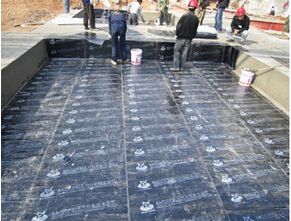
FAQ
Q: What's the de6abf1fe186f8d58506cbcfe46eed814d.jpglivery time ?
A: 3-5 days for 1-600 rolls, 10-15 days for container.
Q: What's the payment terms ?
A: TT/LC
Q: How do you make replacement with quality problems ?
A: New replacement will be packed into your next order or send to you directly after receive video or photo about quality problems.
- Q: Can a waterproofing membrane be used for a roof deck?
- Yes, a waterproofing membrane can be used for a roof deck. It is commonly used as a protective layer to prevent water penetration and ensure the deck remains dry and free from moisture-related issues.
- Q: Can a waterproofing membrane be used for underground bunkers?
- Yes, a waterproofing membrane can be used for underground bunkers. Waterproofing membranes are designed to provide a barrier against water infiltration, which makes them suitable for protecting underground structures such as bunkers from moisture and water damage.
- Q: Does a waterproofing membrane provide any insulation benefits?
- No, a waterproofing membrane does not provide any insulation benefits. The primary purpose of a waterproofing membrane is to protect the underlying structure from water damage by preventing water from penetrating through the surface. It acts as a barrier to keep water out and maintain the integrity of the structure. Insulation, on the other hand, is designed to regulate temperature and prevent heat transfer. It helps to maintain a comfortable indoor environment by reducing the transfer of heat between the interior and exterior of a building. Insulation materials are typically installed within the walls, floors, or roofs to provide thermal resistance and improve energy efficiency. While both waterproofing and insulation contribute to the overall performance and durability of a building, they serve different purposes. Waterproofing focuses on keeping water out, while insulation focuses on regulating temperature. Therefore, it is important to use both waterproofing and insulation materials in appropriate areas to ensure the best results.
- Q: Can a waterproofing membrane be used for vehicular traffic areas?
- Yes, a waterproofing membrane can be used for vehicular traffic areas. Waterproofing membranes are designed to protect surfaces from water damage by creating a barrier that prevents water from seeping through. In vehicular traffic areas, such as parking decks or driveways, it is important to protect the underlying structure from water infiltration, which can cause corrosion, deterioration, and expensive repairs. By using a waterproofing membrane specifically designed for vehicular traffic, the surface can be adequately protected from water damage, as well as other potential contaminants like oil and chemicals. These membranes are typically more durable and able to withstand the weight and impact of vehicles, ensuring long-lasting protection. Additionally, some waterproofing membranes offer slip-resistant properties, making them suitable for use in areas where vehicles may need traction. However, it is crucial to consult with a professional to determine the appropriate waterproofing membrane and installation method for specific vehicular traffic areas based on factors such as traffic volume, load capacity, and climate conditions.
- Q: Can a waterproofing membrane be used for water tanks or reservoirs?
- Water tanks or reservoirs can benefit from the use of a waterproofing membrane. These membranes are specially designed to create a barrier that prevents water from penetrating the surface. They are commonly utilized in various applications, including water tanks and reservoirs, to ensure that the stored water remains contained and does not leak or seep into the surrounding environment. Typically, the membrane is applied on the interior surface of the tank or reservoir, providing a durable and watertight seal. This helps to maintain the integrity of the water storage system and prevent any potential water loss or contamination. Furthermore, waterproofing membranes also offer protection against corrosion and structural damage caused by water exposure, thus extending the lifespan of the tank or reservoir. Therefore, implementing a waterproofing membrane is an effective solution for guaranteeing the safety and functionality of water tanks or reservoirs.
- Q: Are waterproofing membranes resistant to hail damage?
- Waterproof membranes serve the purpose of safeguarding against water infiltration, but they do not typically possess resistance against hail damage. Hail has the capacity to inflict substantial harm upon roofing materials, including waterproof membranes, by puncturing or ripping them. This can jeopardize the integrity of the membrane, thereby leading to leaks and water penetration. Although certain membranes may possess a degree of resilience against hail damage, it is important to acknowledge that no waterproof membrane can offer complete protection against all forms of hailstones. Hence, it is prudent to adopt appropriate preventive measures, such as incorporating additional safeguards like hail guards or considering the usage of impact-resistant membranes, in order to minimize the potential damage that may be incurred due to hail.
- Q: Can a waterproofing membrane be used for loading dock levelers and pit walls?
- Yes, a waterproofing membrane can be used for loading dock levelers and pit walls. Waterproofing membranes are designed to provide a protective barrier against moisture and water infiltration. By applying a waterproofing membrane to loading dock levelers and pit walls, it helps to prevent water seepage and potential damage caused by moisture. This is particularly important in areas where water exposure is a concern, such as loading docks and pits where there may be constant exposure to rain, snow, or water from cleaning activities. The waterproofing membrane creates a barrier that keeps the underlying structures dry and protects them from potential water-related issues, such as corrosion, mold growth, and deterioration.
- Q: Can a waterproofing membrane be used for a garden pond liner?
- Certainly! A garden pond liner can be made using a waterproofing membrane. The primary purpose of a waterproofing membrane is to stop water from seeping through it, which makes it a great option for constructing a garden pond with a tight seal. By using a waterproofing membrane, leaks can be effectively prevented, guaranteeing that the water remains within the pond. Moreover, waterproofing membranes are generally long-lasting and can withstand UV rays, chemicals, and punctures, all of which are essential considerations when choosing a material for a pond liner. Nonetheless, it is vital to ensure that the selected waterproofing membrane is specifically designed for pond use and is safe for aquatic life.
- Q: Can a waterproofing membrane be used for train platforms?
- Train platforms can indeed benefit from the application of a waterproofing membrane. Given their exposure to different weather conditions like rain and snow, it is important to address potential water damage and deterioration over time. One effective method is to install a waterproofing membrane on the surface of the platform. This protective barrier prevents water from seeping through and causing harm to the underlying structure. Consequently, this approach not only prolongs the platform's lifespan but also reduces maintenance costs and ensures the safety of passengers and personnel. In addition, the use of a waterproofing membrane can help prevent the growth of mold and mildew, which can negatively impact the health of those using the train platform. All in all, utilizing a waterproofing membrane on train platforms proves to be a practical and efficient solution for safeguarding against water damage and maintaining the infrastructure's longevity.
- Q: How do waterproofing membranes adhere to surfaces?
- Waterproofing membranes adhere to surfaces through the use of adhesive materials, such as modified bitumen or synthetic rubber compounds, which are applied to the surface and bond with it. The adhesive properties of these membranes allow them to create a tight and seamless seal, preventing water penetration and ensuring long-lasting waterproofing protection.
Send your message to us
CE Approved Waterproof Membrane Price , Self Adhesive Textured Roll SBS Waterproof Membrane
- Loading Port:
- Shanghai
- Payment Terms:
- TT OR LC
- Min Order Qty:
- 1000 m²
- Supply Capability:
- 200000 m²/month
OKorder Service Pledge
OKorder Financial Service
Similar products
Hot products
Hot Searches
Related keywords
